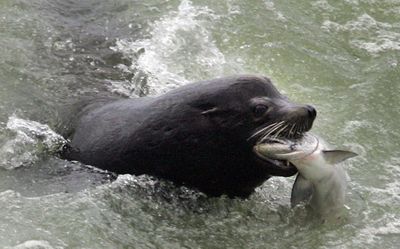Judge rules sea lions near dam can be killed
Humane Society to appeal decision

PORTLAND – A federal judge says state governments can proceed with plans to kill up to 85 California sea lions a year for five years in the Columbia River at Bonneville Dam, where they gather annually to plunder the spring chinook salmon run.
The Humane Society of the United States went to court to block the killings, claiming among other things that the sea lion predation was relatively insignificant compared to threats such as dams, fishing and hungry birds.
A Humane Society official, Sharon Young, says the group will appeal.
Charles Hudson of the Columbia River Inter-Tribal Fish Commission said the decision validated the analysis that the federal agency NOAA Fisheries did in granting “airtight authority” for the states of Oregon, Washington and Idaho to go ahead with sea lion removal.
U.S. District Judge Michael Mosman said in September that he had hoped to rule in a couple of weeks to give the 9th U.S. Circuit Court of Appeals time to decide the case before the spring salmon run and the return of the sea lions.
He ruled that while other factors may contribute to a decline in salmon stocks, the government doesn’t have to take that into account in determining whether to remove predatory sea lions.
Barring a reversal, Hudson said, there still should be time for the states and tribes to get removal plans in place.
In March, NOAA Fisheries authorized the states to kill up to 85 sea lions described as the worst predator offenders and repeat visitors to the dam.
The agency listed about 60 – identifiable by branding, scars or other markings – for “immediate removal” based in part on observed predation. The order encouraged trapping them if possible for placement in aquariums or zoos. Those that can’t be trapped would be shot by marksmen from the shore. Those who are trapped but cannot be placed could be euthanized.
Several sea lions were trapped and sent to marine parks or zoos before six were found dead in a trap at the base of the dam last spring. Two endangered Steller sea lions and a California sea lion pup were among the six that had been trapped for relocation.
Although gunshots were ruled out, federal officials have not determined a cause of death. The plan to kill or permanently remove sea lions has been on hold since then.
The California sea lions, once in sharp decline, are far from endangered and now may number near 300,000. They are protected under the 1972 Marine Mammals Protection Act.
In 1994 Congress passed an amendment to the act that permits the U.S. secretary of commerce to allow states to kill certain identifiable sea lions “which are having a significant negative impact on the decline or recovery” of salmonoid stocks listed as threatened or endangered.
The three states asked in 2006 for authority to remove the sea lions after attempts to shoo them away with firecrackers and beanbags failed.
NOAA Fisheries defined “significant negative impact” as predation that is growing and likely to increase, that has a measurable effect on the number of listed adult salmon and steelhead, and that is comparable to other causes of death that have led to action under the Endangered Species Act.
Mosman wrote in an opinion dated Tuesday that “the statutory text is the authoritative statement of Congress’s intent” and that the government is not required to consider other reasons for the decline of salmon stocks.